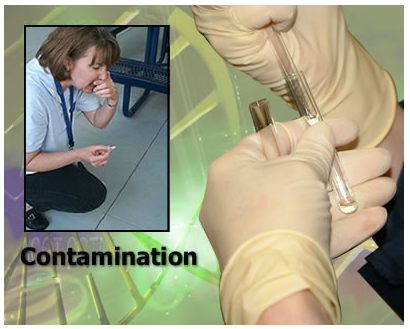Archival Notice
This is an archive page that is no longer being updated. It may contain outdated information and links may no longer function as originally intended.
Home | Glossary | Resources | Help | Contact Us | Course Map
Introduction
Current methods used by forensic DNA laboratories are sensitive and capable of amplifying and detecting low quantities of DNA. With the ability to detect minute quantities of DNA, comes an increased chance of detecting contaminant DNA in both samples and controls. Contamination can happen during any step of the process and can result from a variety of substances, including plant material, bacteria, and human genomic DNA. There are occasions when the source of contamination cannot be determined and/or the incidences are sporadic in nature.
It is not always possible to prevent contamination; however, laboratories should ensure that procedures are in place to:
- Minimize the risk of contamination
- Detect contamination
- Document and implement corrective measures for incidents of contamination
This module focuses on extraneous human genomic DNA deposited after the crime event (during the collection and/or analysis process).
Additional Online Courses
- What Every First Responding Officer Should Know About DNA Evidence
- Collecting DNA Evidence at Property Crime Scenes
- DNA – A Prosecutor’s Practice Notebook
- Crime Scene and DNA Basics
- Laboratory Safety Programs
- DNA Amplification
- Population Genetics and Statistics
- Non-STR DNA Markers: SNPs, Y-STRs, LCN and mtDNA
- Firearms Examiner Training
- Forensic DNA Education for Law Enforcement Decisionmakers
- What Every Investigator and Evidence Technician Should Know About DNA Evidence
- Principles of Forensic DNA for Officers of the Court
- Law 101: Legal Guide for the Forensic Expert
- Laboratory Orientation and Testing of Body Fluids and Tissues
- DNA Extraction and Quantitation
- STR Data Analysis and Interpretation
- Communication Skills, Report Writing, and Courtroom Testimony
- Español for Law Enforcement
- Amplified DNA Product Separation for Forensic Analysts


